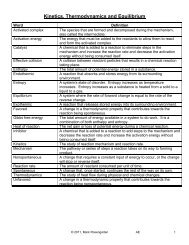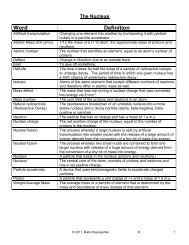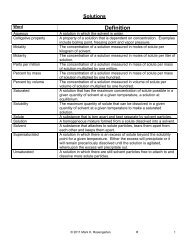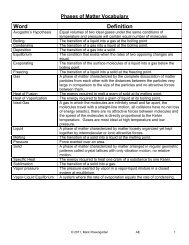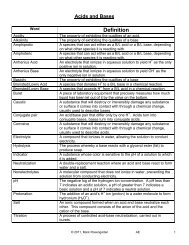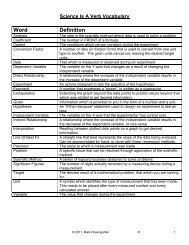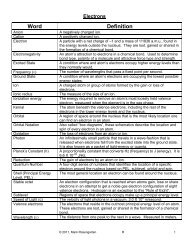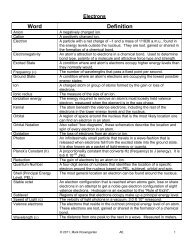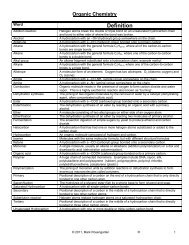Unit 6: Periodic Table and Bonding - Mark Rosengarten
Unit 6: Periodic Table and Bonding - Mark Rosengarten
Unit 6: Periodic Table and Bonding - Mark Rosengarten
You also want an ePaper? Increase the reach of your titles
YUMPU automatically turns print PDFs into web optimized ePapers that Google loves.
PHASES<br />
All elements are solids at 25 o C except the following:<br />
Liquids - Hg, Br<br />
Gases - N, O, F, Cl, H, He, Ne, Ar, Kr, Xe, Rn<br />
Which of the following elements is a nonmetallic gas at 25 o C?<br />
a) Zn b) Br c) Cl d) Hg<br />
Which of the following elements is a metallic liquid at 25 o C?<br />
a) Zn b) Br c) Cl d) Hg<br />
Allotropes<br />
These different forms arise because of the different conditions that elements may be found.<br />
Examples:<br />
Carbon: coal (amorphous mass), diamond (network bonded crystal), graphite (mineral where the carbon atoms are<br />
bonded in weakly connected sheet structures)<br />
Oxygen: O 2 (diatomic oxygen), O 3 (ozone)<br />
Phosphorous: red, white <strong>and</strong> yellow phosphorous<br />
MOLECULE: a particle made of nonmetals atoms that are covalently bonded together. The number of atoms<br />
of each element is consistent from molecule to molecule (for example, a molecule of water ALWAYS contains<br />
two hydrogen atoms covalently bonded to one oxygen atom).<br />
MONATOMIC MOLECULES: Since the noble gases do not react with other elements, the individual atoms are<br />
considered to be "molecules" of that gas. So, Kr is not just considered to be an atom, but a molecule as well.<br />
He, Ne, Ar, Kr, Xe <strong>and</strong> Rn do not bond to other elements, so an atom of each of these can also be considered a<br />
molecule. A molecule made of one atomMONatomic! Mono, meaning one!<br />
Which of the following elements will form monatomic molecules?<br />
a) Zn b) Na c) Ne d) N<br />
DIATOMIC MOLECULES: Certain elements are found free <strong>and</strong> uncombined in nature, but are reactive. To become<br />
stable, they react with themselves, <strong>and</strong> are found as diatomic molecules, two atoms of the element bonded to each<br />
other. These elements are:<br />
Br 2 , I 2 , N 2 , Cl 2 , H 2 , O 2 , F 2<br />
Br I N Cl H O F<br />
When these elements are free <strong>and</strong> uncombined with other elements, they are always found in their diatomic state. For<br />
example, H + H H 2 , H 2 is more stable than H. These can also be thought of as the “Twinkie Molecules”, because<br />
they are always found in a two-pack.<br />
Example: Zn + 2 HCl ZnCl 2 + H 2<br />
The H 2 on the right side is diatomic hydrogen, when not bonded to another element, it forms diatomic molecules.<br />
Which of the following elements will form diatomic molecules?<br />
a) Zn b) Na c) Ne d) N<br />
© 2011, <strong>Mark</strong> <strong>Rosengarten</strong> AE 8



